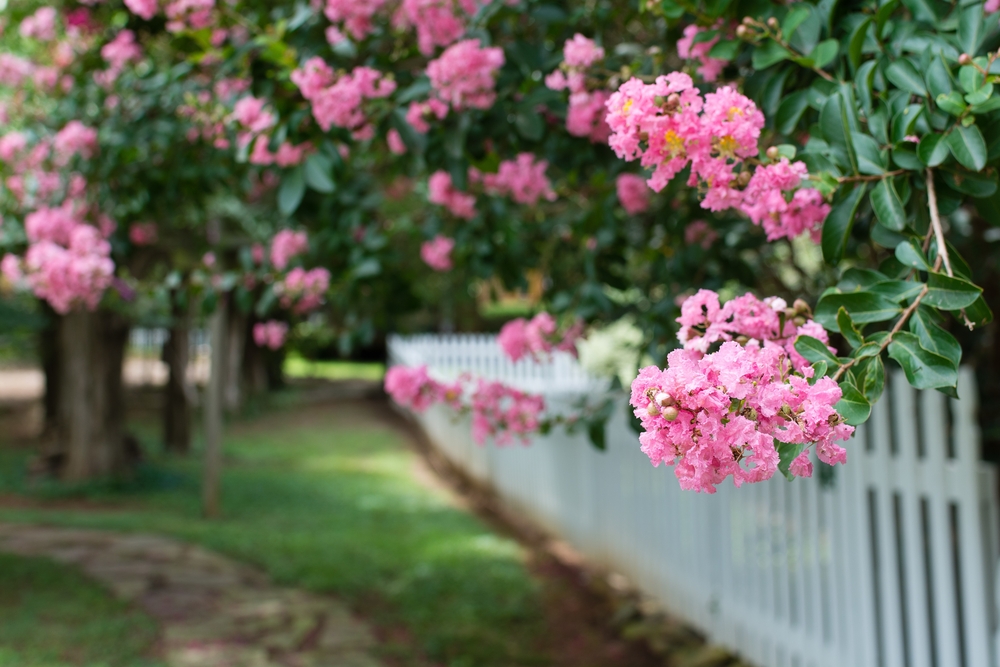Known as one of hardiest shrubs, the Crepemyrtle (sometimes spelled crepe myrtle) is a favorite. It is a native of China and Korea. In the United States, it is known as the “lilac of the South.”
The crepe-paper like petals of the attractive pink flowers are beautifully wrinkled. Against the dark green foliage, the flowers pop with color. In the fall the dark green changes to yellow, oranges and reds.
Why is the Crepemyrtle So Popular to Plant?
The crepemyrtle grows in a wide range of soils from slightly alkaline to acidic.
It prefers moist, well-drained soil but can still be hardy in drought. It is a sun-lover, needing at least 6 hours of sunlight per day. The crepemyrtle is a beloved shrub of lawn care professionals and novices alike.
- It is easy to grow, especially in hot, sunny areas.
- It grows well in limited soil space.
- A crepemyrtle can be grown as a shrub or a tree-depending on how you prune it.
- The blooms are beautiful, and the bark is also attractive as it ages.
- Crepemyrtles grow in a vase shape.
- The blooms are attractive to bees, butterflies. Birds love the crepemyrtle branches.
Crepemyrtle Maintenance Tips
So, what is the secret to having a beautiful crepemyrtle? Actually, there are a few. Though the crepemyrtle is known to be drought resistant, it needs plenty of moisture when it is young, until it is well established.
If you love the crepemyrtle blooms, pinching the new growth will increase the flower number and the branchiness. Most important to the crepemyrtle is the pruning.
Proper bed and bush maintenance is vital to the crepemyrtle. First, proper pruning of the crepemyrtle will allow the formation of pretty, mottled bark on mature trees. Second, it prevents the drooping by eliminating weak branches. Third, proper pruning of your crepemyrtle allows it bloom beautifully every year.
Crepemyrtles bloom on new growth, so the best time to prune is early spring, before they come out of their dormancy. Pruning in the fall can be dangerous for the shrub because it removes the newer growth, which is a shield against winter damage. Crepemyrtle pruning at the right time and in the right manner allows blooming new growth every year and allows you to keep your tree in the shape you desire. Improper pruning, especially when it is hacked too short, is call “crepe murder” by the pros. To avoid “crepe murder,” here are a few tips:
- Try to prune late winter-February is the best time just in case March proves to be an early, warm spring.
- Remove unwanted branches before they are thicker than a pencil.
- Remove “suckers” (new growth from the base of the trunk) from the bottom. Also remove any crepemyrtle branches that are rubbing, growing inward, or cross-growing.
- Cut off any lone or clustered stubs.
- As the tree grows, remove side branches from the main base.
- If you want a more natural look, leave the side branches and simply trim the top growth to create the shape for the space the shrub has.
The common crepemyrtle can grow to a height of 15-25’ and a spread of 6-15’ at full maturity. It is important that you consider the placement of your crepemyrtle as you prune. It can grow as much as 24” per year, so it is vital to keep up your pruning with your plant.
Keep Your Shrubs Healthy with Executive Lawn Care
Whether you are a weekend gardener or an avid gardener, you will enjoy having a crepemyrtle in your yard. You will relish the blooms, the bees and butterflies and the birds that it attracts. It isn’t a plant that requires attention every week or even every month, but you should take the time to keep it pruned and watered. With just a little TLC from Executive Lawn Care this shrub-tree will be a highlight of your landscaping.
Contact us to learn more about our residential scheduling opportunities in your area.



Recent Comments